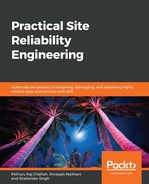Managing dependencies and binaries across many applications and customers requires significant efforts. Having realized the need for a comprehensive-yet-compact mechanism for achieving system portability, the Docker people have combined some of the capabilities of Linux cgroups (https://en.wikipedia.org/wiki/Cgroups) and namespaces into a single and easy-to-use package so that applications can consistently run on any IT infrastructure (bare-metal servers and virtual machines) without any tweak and twist of application code. The resulting package is the Docker image (https://docs.docker.com/engine/docker-overview/), and the following benefits accrue from using out of this standardized image. The Docker platform is a collection of capabilities used to take care of the life cycle activities of Docker images and their container instances.
Let's understand more about Docker platform with the help of the following points:
- The Docker image packages the application and the associated libraries into a single package. This helps applications to be consistently deployed across many environments including Raspberry Pi, laptops, enterprise IT servers, cloud servers, and so on.
- The Docker platform provides a variety of Git-like semantics, such as Docker push and Docker commit, to make it easy for application developers to quickly produce Docker images and containers and incorporate them into their existing workflows.
- Docker images are immutable. Committed changes are stored as individual read-only layers. This makes it easy to reuse images and track changes. Layers also save disk space and network traffic by only transporting the updates instead of the entire images.
- Docker containers get realized by instantiating the immutable images instantaneously with a writable layer that can temporarily store runtime changes, making it easy to deploy and scale multiple instances of applications quickly.
Though there were many containerization-enablement technologies and methods, the success of the Docker platform has brought in a real paradigm shift. The huge amount of simplification and standardization brought in through a variety of automation techniques, and tools has made it possible for containers to be pervasive. Containerization is being touted as the next-generation compartmentalization technique for realizing next-generation cloud environments that open up fresh possibilities and opportunities for businesses as well as the technology industry. It is an indisputable statement that the future definitely and decisively belongs to the mesmerizing success of the containerization paradigm. To achieve digital transformation, all the innovations and disruptions provided by the containerization technology are going to be the real game-changer. Containerization is all set to be the fundamental spark for achieving bigger and better things through a host of technological advancements in the days to come.
